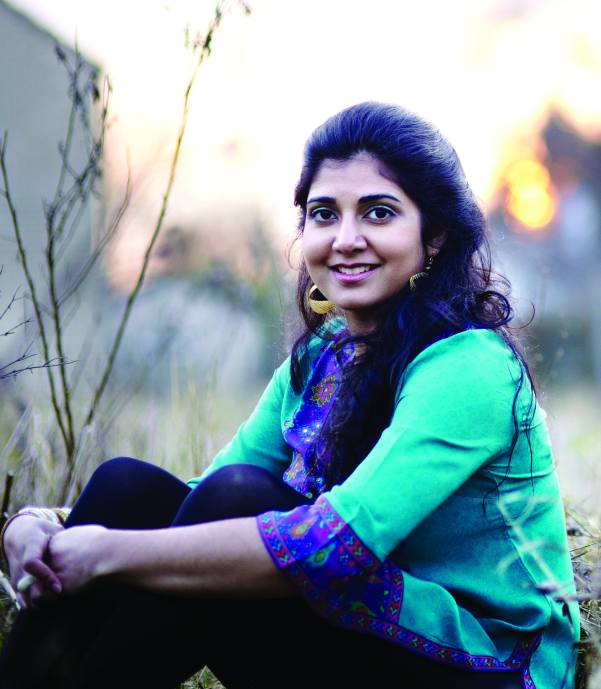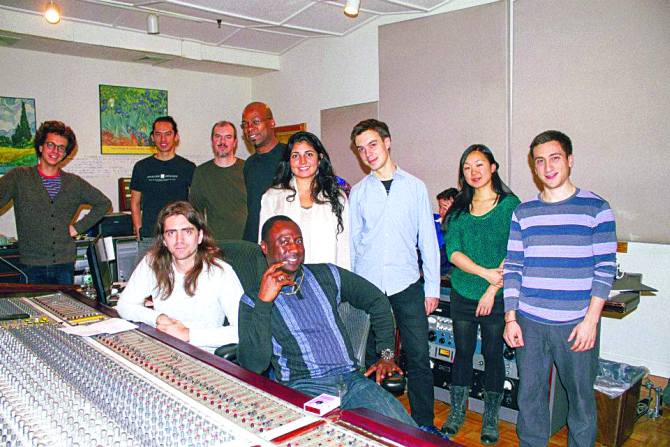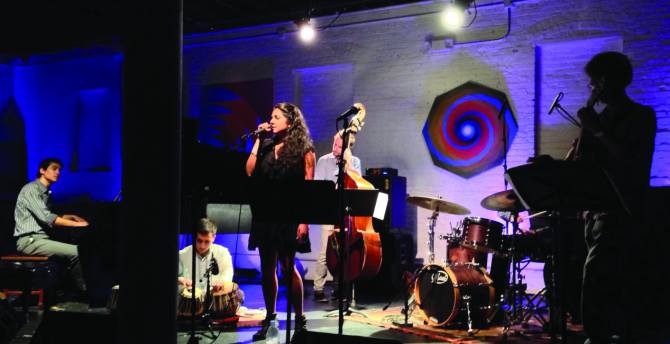Chaya Babu
Chaya Babu discovers the musical influences that shape the unique vision of singer Kavita Shah
It was a chilly Thursday afternoon and everyone in New York was coming down with something after the slow months of gray winter. Kavita Shah had to almost cancel our meeting because she woke up with that knowing, groggy feeling of an impending cold -- a dreaded moment for all of us who have things to do, but likely worse for a singer.
She decided to push through though, and when she finally arrived at Bowery Coffee in a puffy jacket over a sweater, her curly hair in a flowing mass around her rosy-cheeked face, I could hear the congestion. She just needed to be gentle to make sure she doesn’t hurt anything, she told me; so we chatted quietly about her upcoming album and her recent show at The Rubin Museum over the coffee shop’s poor interpretation of Masala Chai.
Visions, her debut album, drops this month. With that right around the corner, being released on a small label called Inner Circle Records, Shah -- Downbeat’s Best Graduate Jazz Vocalist (2012) and winner of an ASCAP Herb Alpert Young Jazz Composers Award (2013) -- is working hard on the various bits leading up to the release.
“It’s an exciting time because this is my first CD, and I hope it gets out there and leads to more opportunities to share the music with more people,” she said. “But it’s definitely a little nuts. I’m preparing for a few concerts, and being a band leader means organising rehearsals, organising logistics, coordinating with publicist, coordinating printing of album with label, getting copyrights in order, all these little, little pieces.”
On Visions, her collaborators include Lionel Loueke on guitar and vocals, who co-produced the album and whom Shah credits as having been hugely influential to her career; Steve Wilson, sax and flute; Yacouba Sissoko, kora; Stephen Cellucci, tabla; Rogerio Boccato, percussion; and Linda Oh, bass. Together, the group creates fresh iterations of Joni Mitchell’s Little Green, Antonio Carlos Jobim’s Triste, a few of Shah’s original pieces, three ragas, and more.
From the track list alone, it’s clear that Shah has had a range of musical influences that have mingled to create her style, one that is soulful and certainly rooted in jazz, a distinctly American art form, but also pulls in threads of what she has learned and listened to throughout her lifelong exposure to cultures from around the globe. She mentions names and genres, some familiar and others utterly obscure, that have inspired and paved the way for her: Sheila Jordan, Meredith Monk and John Tavener, Hungarian folk music Stevie Wonder, morna, samba, bossa nova, Samir Chatterjee, hip-hop, Touamani Diabate and Ali Farka Toure.
Yet, despite the varied textures, rhythms, and roots of her musical identity, the overall sound has unity and cohesion.
Her fall appearance at Brooklyn’s Shapeshifter Lab showed her spunky and unrestrained, crooning out her own rendition of upbeat tracks like M.I.A.’s Paper Planes with tablas as well as a more haunting Portuguese tune Sodade by Cesaria Evora.
Months later, her performance at The Rubin Museum in Chelsea, a first-time duo with Loueke, was soft and vulnerable, something you felt privileged to witness because Shah was on the shy side, experimenting with and exploring new terrain.
Still, both of these evenings brought out what is unfailingly Kavita Shah, her voice like honey over lyrics in different languages.
“When I heard her, I was immediately dumbfounded,” Greg Osby, who runs Inner Circle Records, told India Abroad. “She sounded very mature -- there was a host of characteristics with her delivery that were evocative of another era and another time. Some people call that an ‘old soul,’ someone who’s lived a long life and experienced a lot. Obviously she has it. And obviously that was very special.”
Please click NEXT to continue reading
All that Jazz: The desi singer who's hitting the right tunes
Image: Kavita Shah (centre, standing) with her teamOsby met Shah last year at the EPCOR Center for Performing Arts in Calgary, Canada, where she was studying and he was an instructor. When she approached him, he was impressed by her vast knowledge, her maturity, and the curiosity evident from her probing questions. After seeing her play at one of the evening student jam sessions and then hearing that she was in production of her first record that things started to come together. They decided to stay in touch in New York.
“That struck my interest, of course, because I seek out people who are eclectic and very individualistic in their approach, their whole concept,” he said. “They drew from a broader variety of sources than expected. She embodied all of those traits, and she’s a truly global artist. That’s primarily the resounding theme of our label. We probably host one of the most nternational rosters of any that I’ve seen, and that made her a custom fit for what we are about and what we do.”
Shah’s upbringing in New York City and the life that came from that is what has led her to grow into what Osby describes.
At 10 years old, she began singing with the Young People’s Chorus of New York City, through which she learned and became obsessed with Ella Fitzgerald’s A-Tisket A-Tasket, the start of her love for a mix of jazz traditions.
It was rigorous musical training, a programme that brought together children from all over the city and diverse racial and socioeconomic backgrounds. Some of the kids had never seen anything close to the interior of a Park Avenue apartment, where donor events would sometimes be held, but they sang at Carnegie Hall. Together the chorus rehearsed three times a week and had 40 to 50 performances a year.
Here Shah learned not just jazz, but pop, gospel, classical, folk styles from around the world, and more. She acknowledged that ‘authentic’ is a complicated term, but is thankful for the way the YPC forced her to always understand the heart of the types of music they were working with.
On her own as a teenager, she sought out Brazilian and Cuban music, trying to get the pronunciations in the lyrics correct, just as she’d learned to do through the choir. It was a passion that stuck.
“I think the journey from there, from my family life and childhood, in terms of my own life or own influences are just as real too: Growing up among a large Hispanic population in New York and having the Spanish language around me, that’s a big part of who I am,” she said. “I grew up studying Spanish and lived with a family in Ecuador when I was 16, and suddenly the language became connected to people and experiences, and that’s when I got really into it.”
At Harvard, she majored in Latin American Studies and ended up in Salvador for a study-abroad programme. This was pivotal: She described Salvador as a magical city that not only showed her a world where brown was mainstream, but that also showed her music as a way of life.
By this point, Shah’s family was just her and her mother. Her father passed away when she was at 18, and then all four of her grandparents, who had been around to help raise her, also passed away within three years. She looks back at this time as a moment that severed her cultural connections to India in a way, since the older generations were her direct tie to the subcontinent. But other vibrant places drew her in.
“Sometimes it’s easier to look through another lens versus looking in the mirror when it comes to thinking about culture, and that’s what I think studying other languages did for me,” she said. “And they eventually brought me back. There’s not straight line; it’s more of a kaleidoscope.”
Her circuitous path has brought her back in a way. At The Rubin Museum, with Lionel Loueke on the guitar, Shah paid homage to her own ethnic roots and sang a Gujarati folk song for the first time, as well as her original composition, Loej, named after her grandmother’s village in India where the men pay the dowry. Along with this, the pair did their original Rainwash; Herby Hancock’s Alone with Shah’s own lyrics over it; Benny’s Tune, in Fon, a Beninese language; and songs from the album, including, Sodade and Oju Oba. And they did a lot of playful freestyling.
Please click NEXT to continue reading
All that Jazz: The desi singer who's hitting the right tunes
Image: Kavita Shah performing at a showShah’s tentative yet excited energy shone in the spotlight in a black room where the small audience sat, rapt and silent.
“That space is a very intimate setting, and it was just the two of us and a special guest Rogerio Boccato, who’s a great percussionist from Brazil, and the idea, well for me anyway, was that it was a chance to be really honest and intimate,” Shah said. “In that kind of situation, there’s no other way to do it. You’re so exposed in a duo setting. There’s nowhere to hide. And especially in that big of a room, you have nowhere to go except to just be there and be honest. And that was the beauty of that concert: I knew I could be that person with Lionel, and I wanted it to be that fragile, vulnerable experience.”
When she speaks of Loueke, her admiration is lucid. His music is hard, really hard, she said; it’s rhythmically challenging, in a meter of 15, as opposed to 4-4 or 3-4. Still, despite his being such a complex and accomplished musician and mentor, she feels like she can be entirely herself with him. He is a safe place for her.
Part of that is his own international understanding of music because of his background. Loueke, now a New Yorker, is from West Africa and has lived in France, so he incorporates extensive and assorted traditions and instrumentation into his work, just like Shah -- or perhaps it’s the other way around considering Loueke’s expertise.
“I felt that if there’s one person out there who does what I’d like to be doing, it’s him in terms of having a formation in jazz that informs his approach but having a real openness and kind of ear to the ground,” she said. “When we talked about the album, I didn’t even have to explain to him what I’m trying to do; he just understood right away. So that was a very exciting collaboration.
“One thing I think about a lot is that part of being this modern global citizen is having disjointed parts, memories in different places, connections to people and cultures that are all separate. When you’re one person at the nexus of all of that, it’s beautiful because it enriches your life, but it’s also very lonely because there are very few people you can share that singular perspective with. So that’s something I felt I can share with Lionel. He understood from the beginning who I was and how I was trying to put that into music.”
Shah’s vision comes through on Visions, the track list including Moray, Deluge, and a raag Desh Meltdown, on top of what she performed at The Rubin Museum and Shapeshifter. In the next weeks she and the whole band will be continuing to bring this to audiences through their first wave of shows leading up to the album drop and after the May 27 release, a few gigs on the West Coast this summer.
Osby said he looked positively to the album’s reception due to Shah’s novel style: “She comes up with a sound that’s far more personal and far more detailed than people who have been out many years before her. That’s a huge selling point: here’s somebody who’s taken all of these resources and beautifully and respectfully corralled them into something that sounds truly original. People use that word recklessly – unique and new and all that – but her sound is truly that.”




Comment
article